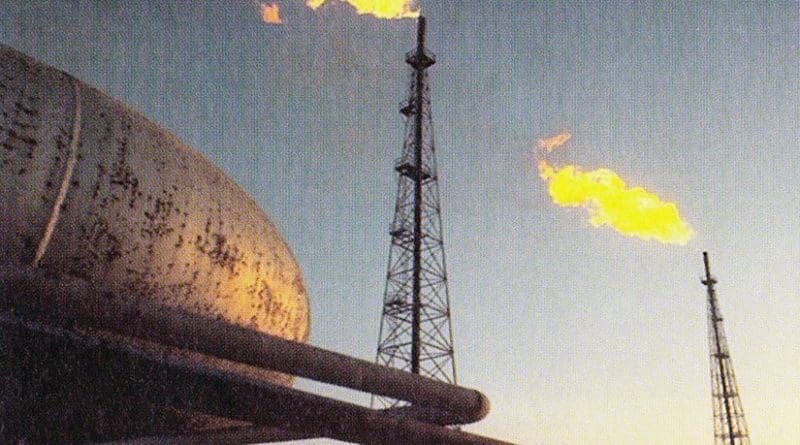The Five Countries That Could Push Oil Prices Up – Analysis
By OilPrice.com
By Nick Cunningham
Oil prices appear to be stuck in the $50s per barrel, but that doesn’t mean there aren’t serious supply risks to the market.
An unexpected disruption could occur at any moment, as has happened in the past, leading to a sudden and sharp jump in prices. Geopolitical tension has been largely irrelevant since the collapse of oil prices in 2014, but it’s making a return now that cracks have emerged in some key oil-producing nations. The threat of an outage will carry more weight as the oil market tightens.
“The ‘Fragile Five’ petrostates—Iran, Iraq, Libya, Nigeria and Venezuela—continue to see supply disruption potential, with northern Iraq crude exports at risk due to an escalation of tensions between the (Kurdistan Regional Government), Baghdad and Turkey, while the United States has decertified the 2015 Iran nuclear deal,” U.S. bank Citi said.
Indeed, five prominent oil-producing nations are beset with challenges, for varying reasons, all of which could spring a surprise on the oil market without any advanced notice.
Iraq. The most near-term supply risk comes from Iraq. The surprise seizure of Kirkuk’s oil fields by the Iraqi government has already disrupted some oil shipments. The Bai Hassan and Avana oil fields near Kirkuk remained shut as of October 19, keeping at least 275,000 bpd offline. The outages are expected to be temporary; a source told Reuters last week that they’re seeking certain equipment to bring the fields back online. An agent at the Turkish port of Ceyhan—the destination for Iraq’s northern oil exports—told Bloomberg that flows fell to 196,000 bpd as of October 19, implying an outage of about 400,000 bpd. Iraq represents the most obvious near-term threat to global supplies, but because the bulk of the country’s output is located in the south, far from the unrest, the potential outage is likely capped at 600,000 bpd, and would probably be temporary.
Iran. This one’s probably the biggest question mark on this list, and is in a much stronger position than its more fragile peers. The danger to Iran is a return of U.S. sanctions, which are by no means a given. Even then, it’s unclear if the U.S. has the ability to curtail Iranian oil exports. It might scare away new investment, but even U.S. Secretary of State Rex Tillerson went to lengths recently to assure European officials that it wouldn’t block business between European companies and Iran. Goldman Sachs estimates that in a relatively worst-case scenario of a return of U.S. sanctions, a few hundred thousand barrels of oil exports would be at risk—not the more than 1 mb/d of disrupted exports due to sanctions before the nuclear deal. At this point, though, potential outages are too hypothetical to be taken seriously. Iran probably won’t pose a supply risk to the market, at least not this year.
Libya. The North African OPEC member was exempted from the OPEC deal, and for much of the past year has represented a downside risk to oil prices, not an upside one. That is because it has nearly tripled its output from about 300,000 bpd in August 2016 up to about 850,000 bpd currently, down a bit from a recent peak at over 1 mb/d. But damage to some export terminals likely means that near-term production has a ceiling at about 1.25 mb/d, meaning Libya won’t be able to bring output back to pre-war levels of 1.6 mb/d. But because current output is now taken for granted and already baked into global pricing calculations, Libya now represents a supply risk to the market because an outage is entirely realistic due to ongoing instability. The country is nearing its ceiling for production, while there’s plenty of room for it to fall back.
Nigeria. The story here is similar to Libya. It was also exempted from the cuts because violence and instability previously knocked a sizable portion of output offline. But Libya’s restoration of output coincided with a similar reduction in violence in the Niger Delta. A ceasefire brought calm for much of the past year, allowing production to rebound from a low point of 1.2 mb/d last year, back up to 1.8 mb/d currently. Potential for further output gains is probably limited, not least because the country promised to limit production when it hit 1.8 mb/d. Meanwhile, peace in the Niger Delta remains fragile, and reports that militants have grown frustrated with the pace of talks with the government raises concerns about a return to violence. The rebound in Nigerian production is not assured.
Venezuela. The unfolding implosion of Venezuela almost ensures that more of the country’s oil production will erode, perhaps at a quickening pace. As of September, Venezuela only produced 1.89 mb/d, down from 3.2 mb/d in the late 1990s, but also down from nearly 2.4 mb/d as recently as 2015. Without cash, state-owned PDVSA can’t invest in new production and can’t even invest in maintenance to keep existing production from falling. Reports have surfaced suggesting that even the oil that is produced is suffering from declining quality, as PDVSA doesn’t have the means to properly treat its heavy crude. Worse, with huge debt payments coming due in the next few weeks, a debt default is possible. All of this adds up to a further deterioration in the country’s oil output.
Source: https://oilprice.com/Geopolitics/International/The-5-Countries-That-Could-Push-Oil-Prices-Up.html

